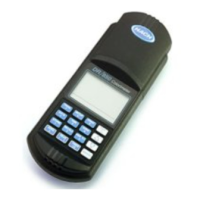390
Interferences
Summary of Method
In a highly acidic solution, ammonium molybdate reacts with
orthophosphate to form molybdophosphoric acid. This complex
is then reduced by the amino acid reagent to yield an intensely
colored molybdenum blue compound.
REQUIRED REAGENTS
Cat. No.
High Range Reactive Phosphorus Reagent Set (100 Test)...........................................22441-00
Interfering Substance
Interference Levels and Treatments
Calcium (Ca
2+
) Greater than 10,000 mg/L as CaCO
3
Chloride Greater than 150,000 mg/L as Cl
-
Colored samples Add 1 mL of 10 N Sulfuric Acid Standard Solution to another 25-mL sample. Use
this instead of untreated sample as the blank to zero the instrument. Use a pipet
and pipet filler to measure the sulfuric acid standard.
High salt levels (Na
+
) May cause low results. To eliminate this interference, dilute the sample until two
successive dilutions yield about the same result.
Magnesium Greater than 40,000 mg/L as CaCO
3
Nitrites (NO
2
-
) Bleach the blue color. Remove nitrite interference by adding 0.05 g of sulfamic
acid to the sample. Swirl to mix. Continue with Step 4.
Phosphates, high levels
(PO
4
3-
)
As the concentration of phosphate increases, the color changes from blue to green,
then to yellow and finally to brown. The brown color may suggest a concentration as
high as 100,000 mg/L PO
4
3-
. If a color other than blue is formed, dilute the sample and
retest.
Sulfide (S
2-
) Sulfide interferes. For samples with sulfide concentration less than 5 mg/L,
sulfide interference may be removed by oxidation with Bromine Water as follows:
1. Measure 50mL of sample into a 125-mL flask.
2. Add Bromine Water dropwise with constant swirling until permanent yellow
color develops.
3. Add Phenol Solution dropwise until the yellow color just disappears. Use this
sample in Steps 3 and 7.
Temperature For best results, sample temperature should be
21 ±3 °C (70 ±5 °F).
Turbidity May give inconsistent results for two reasons. Some suspended particles may
dissolve because of the acid used in the test. Also, desorption of orthophosphate
from particles may occur. For highly turbid samples, add 1 mL of 10 N Sulfuric
Acid Standard Solution to another 25-mL sample. Use this instead of untreated
sample as the blank to zero the instrument. Use a pipet and pipet filler to measure
the sulfuric acid standard.
Highly buffered samples or
extreme sample pH
May exceed the buffering capacity of the reagents and require sample
pretreatment.
PHOSPHORUS, REACTIVE, continued

